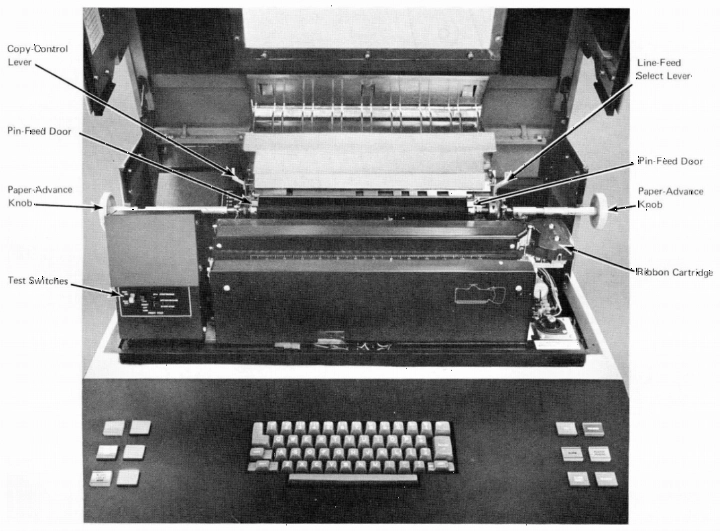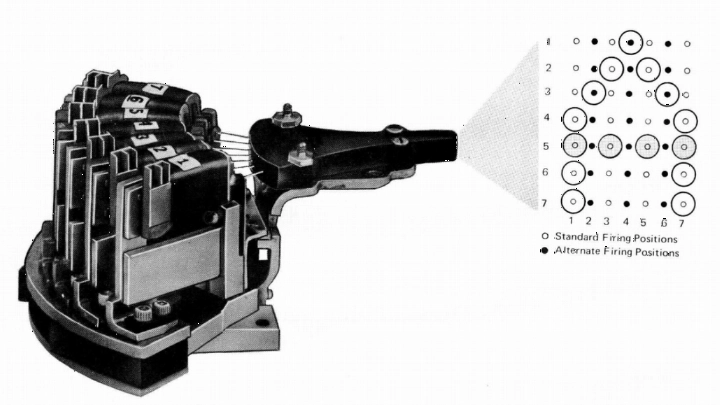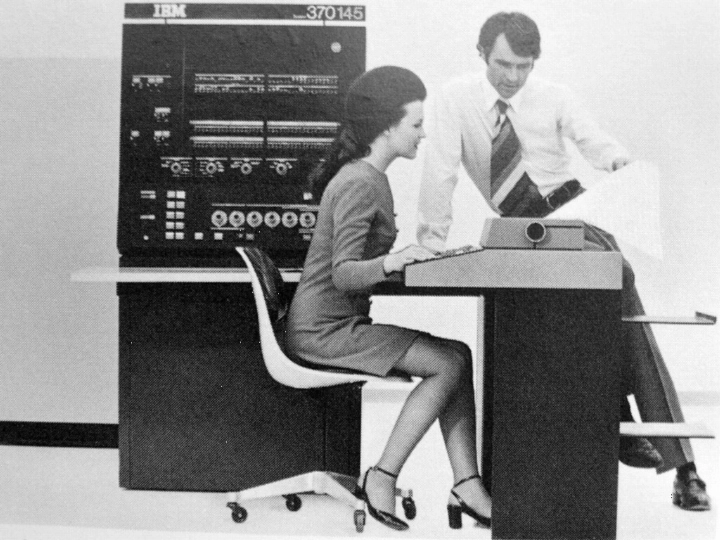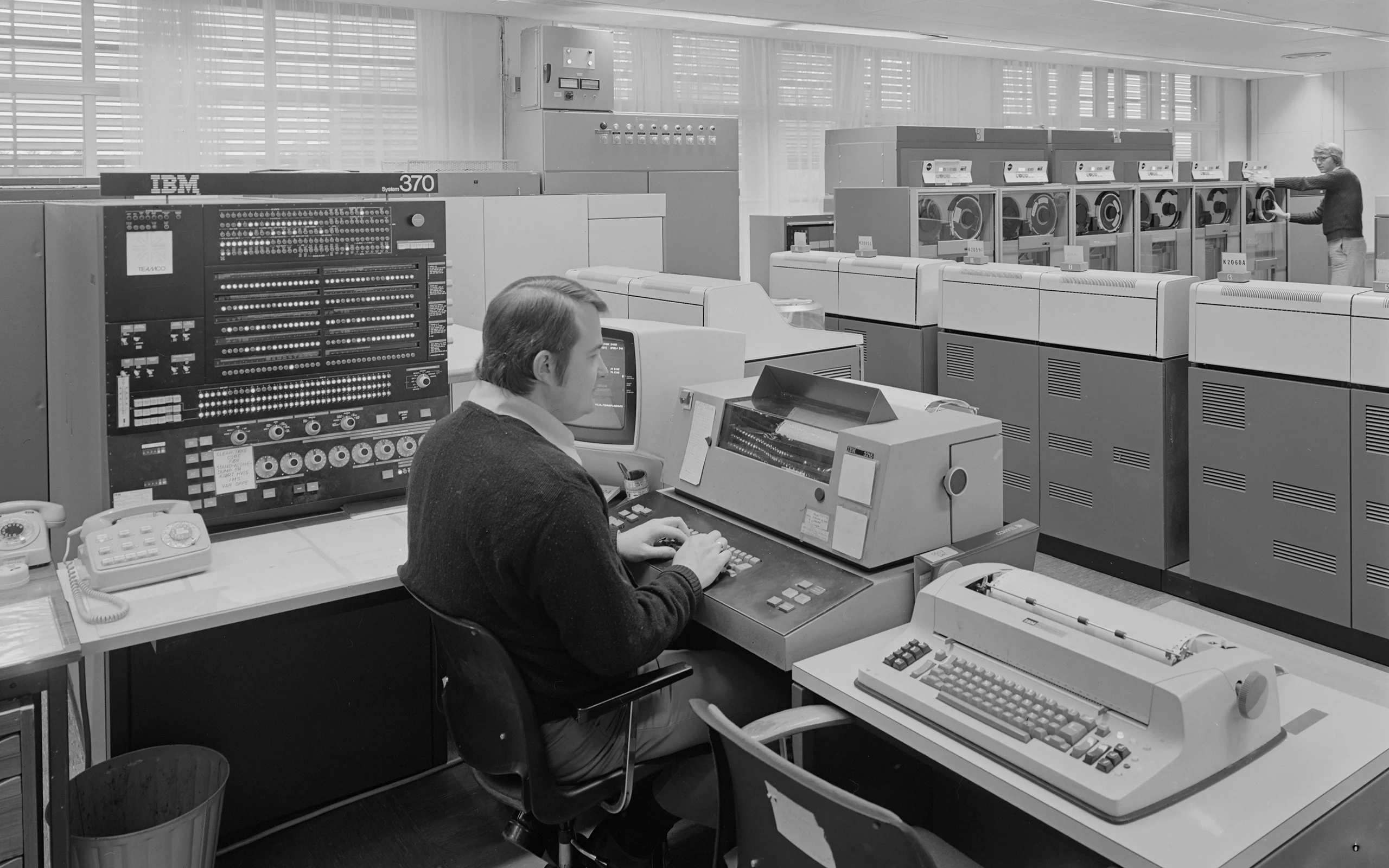IBM 3210 & 3215 Console Printer-Keyboards
- Updated
The IBM 3210 and 3215 Console Printer-Keyboards were a trio of typewriter printer-keyboard consoles introduced in late 1970 for IBM System/370 mainframe data processing systems. The series is comprised of 3210 Model 1, 3210 Model 2 and 3215, all of which were at least compatible with IBM System/370 models 135, 145[2], and 155.[3] They acted as input/output terminals providing two-way communication between the operator and an attached IBM host processor, auxiliary to the large control panel on the host processor itself.
3210 and 3215 performed the same overall functions, but differed by their use of an IBM Card Punch based keyboard assembly and slower but well-established Selectric printer or an IBM Elastic Diaphragm based keyboard assembly and new and faster dot-matrix printer technology respectively. 3210 was further divided into two models for directly-attached table mounting and external pedestal mounting. The keyboard uses a layout based on that of IBM 1052 Printer-Keyboard like most IBM System/360 and 370 family console keyboards.
Contents
| Marketing names | 3210: IBM 3210 Console Printer-Keyboard 3215: IBM 3215 Console Printer-Keyboard IBM 3215 Wire Matrix Printer[4] |
|---|---|
| Family | Typewriter printer-keyboard |
| Type numbers | 3210, 3215 |
| OEMs | IBM |
| Patents | USD223762S - Data printer keyboard console (3215 design) USD224605S - Printer (3210 Model 2 design) |
| First appeared | 23rd September 1970 (announced)[5] |
| Withdrawn | 3210: 16th October 1979[5] 3215: 10th December 1982[5] |
| Production period | At least 1970 to 1982 |
| Keyswitches | 3210: IBM Card Punch contact bails 3215: IBM Elastic Diaphragm |
| Keycaps | Multi-shot SAN |
| Layout | All: 51-key 1052-style console 3210-1 & 3215 only: 7-key, 5-indicator panel 3210-2 only: 8-key, 4-indicator panel |
IBM 3210 and 3215 were both announced on 23rd September 1970.[5] United States design patents for 3215 and 3210 Model 2 were filed on 21st December 1970 (223,762, "data printer keyboard console") and 10th May 1971 (224,605, "printer") respectively. Both list Loring C. Bixler, Arnold M. Davis, Walter S. McCormick, Jr. and Edward R. Wiener as their inventors.[6][7]
IBM 3210 and 3215 were withdrawn from availability on 16th October 1979 and 10th December 1982 respectively.[5]
Selectric-based printer (3210)
Both 3210 models used the same IBM Selectric I/O-II printer, which was a then-new introduction. It uses the same 88-character "golfball" typing element and standard Selectric cartridge fabric ribbons as typical IBM Selectric I and II electric typewriters. It can type at 15.5 characters per second and its carrier return speed is approximately 38.1cm (15") per second.[8]
Dot matrix-based printer (3215)
3215 used a dot matrix printer (sometimes called a wire matrix printer by IBM) with a 7-column, 7-row matrix print head. The head consists of seven elements that can each strike to make a dot up to four times per character and can move to three alternative positions to allow for curved and diagonal dots. It can move at a rate of 21.59cm (8.5") per second regardless of printing or moving spaces. When inputting data (manual typing), the printer is capped at 15 characters per second as that is the maximum rate characters can be sent to the host. But whilst under program control, it can print at a rate of up to 85 characters per second.[9]
3210 and 3215 contain a typewriter keyboard and an operator control panel surrounding it made up of 12 keys or lights.
Keyboard
Update from today
This section contains new or updated content added within the last 30 days!
The keyboard's physical layout is that of the 51-key design used on various IBM Selectric I and II electric typewriters. It uses the 88-character IBM 1052 functional layout[9], with 1052 being an earlier printer-keyboard used for IBM System/360 whose layout was adopted by many subsequent IBM mainframe console keyboards.
Despite being physically present, the L-shaped key in the top-left (used as the Tab key on standard typewriters) and the 1.25-unit key in the top-right (Backspace) are not utilised by 3210 or 3215.[10]
Operator control panel
Both 3210 and 3215 sport two 2x3 banks of keys and light indicators on either side of the keyboard for core operations and indicating the status of the device itself and the host processor's handling of said device. 3210 Model 1 and 3215 have the same set of controls, but 3210 Model 2 has two different keys (including one that can also light up).
| Legend | Type | Function |
|---|---|---|
ALARM | Light | Indicates the system requries manual attention |
ALARM RESET | Key | Resets the ALARM indicator |
CANCEL | Key | Terminals a read operation |
END | Key | Terminates a read, write or store operation |
INTVN REQD | Light | (Intervention Required) Indicates the operator pressed the NOT READY key, the printer is out of paper, or the device is presently open |
NOT READY | Key | Puts the device into an "offline" state |
PROCEED | Light | Indicates the device is allowed to input data to the system |
READY | Key | Puts the device into an "online" state after all INTVN REQD conditions are resolved |
REQUEST | Key | Tells the system that the operator is ready to input data |
REQUEST PENDING | Light | Indicates the REQUEST key was pressed but the system is not ready to accept data |
3210 Model 1/3215 specific
| Legend | Type | Function |
|---|---|---|
ALTER/DISPLAY | Key | Requests an alter/display operation |
ALT/DISP MODE | Light | (Alter/Display Mode) Indicates a requested alter/display operation was accepted |
3210 Model 2 specific
| Legend | Type | Function |
|---|---|---|
POWER OFF | Key | Turns off AC power to the printer's drive motor |
POWER ON | Key w/ light | Turns on AC power to the printer's drive motor (the key will also light up when said power is on) |
Notes
- "Device" refers to the IBM 3210 or 3215 itself.
- "System" refers to the host IBM System/370 and the attachment circuitry between it and the device.
- "Alter/display" (A/D) is a feature of IBM System/370s that provides a console operator the means to access defined storage areas such as general, control and floating-point registers, current program status word (PSW), and main storage without interfering with any concurrent I/O operations.[3]
The 3210 Model 1 (3210-1, feature code SPK[12]) is the table-mounted version of 3210 that sits right next to the host IBM System/370 processor and derives its AC power from it. All 3210 models mate an IBM Selectric I/O-II printer to an IBM Card Punch style keyboard assembly. Compared to Model 2, this version is capable of altering or displaying data in the host's storage and has two shelves at the back for holding paper (a lower one for holding blank forms and an upper one for holding printed forms).[8]
The 3210 Model 2 (3210-2, feature code DPK[12]) is the pedestal-mounted version of 3210 that connects to a host IBM System/370 processor via an external signal cable and requires its own AC power source. All 3210 models mate an IBM Selectric I/O-II printer to an IBM Card Punch style keyboard assembly. Compared to Model 1, this version is not capable of altering or displaying data in the host's storage and has only one shelf for holding printed forms as they emerge from the printer (supply is instead from a source placed on the floor). However, because its power supply is independent of the host processor, 3210-2 is given its own power controls for the printer's drive motor.[8]
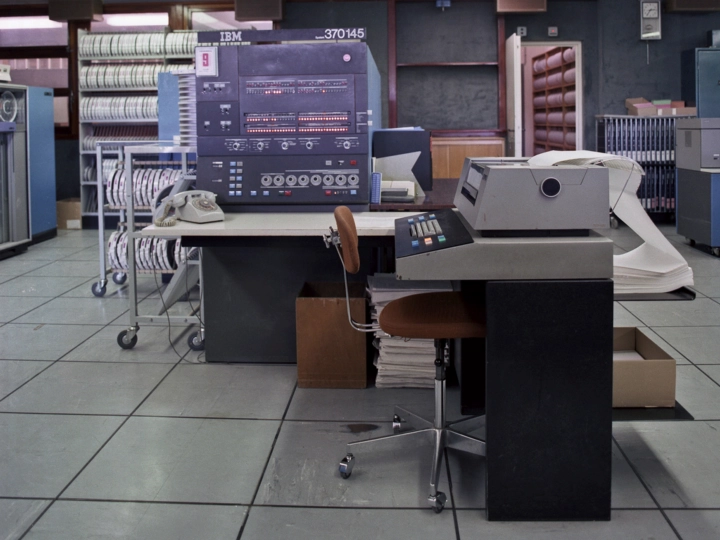
The 3215 (feature code MPK[12]) is a console printer-keyboard that mates a dot matrix printer with a 7x7 printing element to an IBM Elastic Diaphragm encoded keyboard assembly. Compared to any 3210, it can print up to approximately 85 characters a second versus just ~15.5. However, it otherwise has the same level of functionality as 3210 Model 1. Like 3210-1, it is a table-mounted device that sits right next to the host IBM System/370 processor and derives its required AC power from it. It is capable of altering or displaying data in the host's storage and has two shelves at the back for holding paper (a lower one for holding blank forms and an upper one for holding printed forms).[9]
3215 can be referred to as 3215 Model 1 (3215-1), although this is redundant as no other 3215 model has been observed.
Component part numbers
Update from today
This section contains new or updated content added within the last 30 days!
- P/N 1985645: CPU to 3210-1 signal cable[14]
- P/N 1993036: CPU to 3210-1 adapter[12]
- P/N 1993687: CPU to 3210-2 adapter[12]
- P/N 1993715: CPU to 3215 adapter[12]
- P/N 1993761: CPU to 3215 signal amplifier cable[14]
- P/N 1993763: CPU to 3215 signal cable[14]
- P/N 1993765: CPU to 3215 keyboard signal cable[14]
- P/N 1993989: CPU to 3215 DC power cable[14]
- P/N 1994531: CPU to 3210-1/3215 lights and switches signal cable[14]
- P/N 2637218: PF to 3210-1/3215 AC power cable[14]
- P/N 2637735: 3210 cover assembly[14]
- P/N 5756324: 321X label assembly[14]
- P/N 5756348: 321X label holder assembly[14]
- Ørnelund Leif Krohn, Olso Museum - Teamco a.s. & Co., interiør, datamaskiner, menn [accessed 2025-07-07]. License/note: CC BY-SA 4.0 (cropped).
- IBM - IBM System/370 System Summary: Processors (#GA22-7001-7) [accessed 2025-07-08]. License/note: document archived by bitsavers, photos used under fair dealing.
- IBM - IBM System/370 Model 155 Functional Characteristics (#GA22-6942-1) [accessed 2025-07-08]. License/note: document archived by bitsavers.
- IBM - IBM 3215 Wire Matrix Printer [accessed 2025-07-04].
- IBM - IBM Hardware List as of 12/15/87 [accessed 2025-07-04].
- IBM - Data printer keyboard console [accessed 2025-07-04]. License/note: provided by Google Patents, figures used under fair dealing.
- IBM - Printer [accessed 2025-07-04]. License/note: provided by Google Patents, figures used under fair dealing.
- IBM - IBM 3210 Console Printer-Keyboard Component Description (#GA24-3552-1) [accessed 2025-07-04].
- IBM - IBM 3215 Console Printer-Keyboard Component Description (#GA24-3550-1) [accessed 2025-07-04].
- IBM - IBM 3145 Processing Unit Theory - Maintenance (#SY24-3581-1) [accessed 2025-07-12]. License/note: document archived by bitsavers.
- John Keogh - IBM System/370 Model 145 [accessed 2022-02-04]. License/note: CC BY-NC 2.0.
- IBM - IBM System/370 Model 145 Reference Summary (#S229-2239-1) [accessed 2025-07-12]. License/note: document archived by bitsavers.
- Jean Weber - File:1968 CNRZ mécanographie-6-cliche Jean Weber.jpg [accessed 2022-02-04]. License/note: CC BY 2.0.
- IBM - IBM System/370 Model 145 Installation Instructions (#SR25-5608-0) [accessed 2025-07-12]. License/note: document archived by bitsavers.
| Published | Comment |
|---|---|
| 12th July 2025 | Added "Component part numbers" section, corrected 3215 being Card Punch based to Diaphgram based |
| 8th July 2025 | Revamped with new introduction, summary, printers and layout sections |
